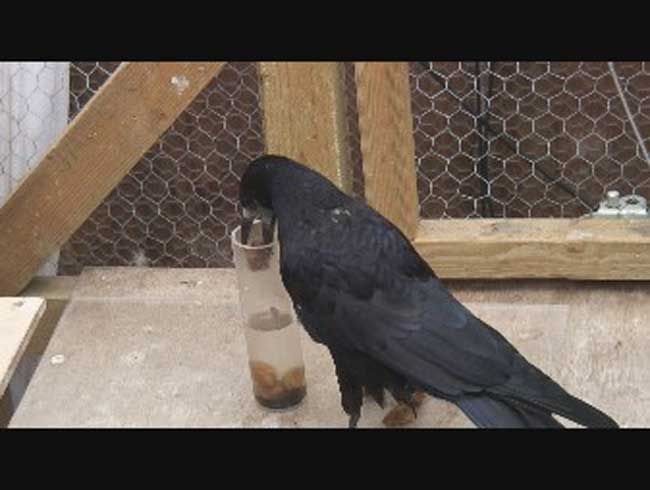Bird's Tool Use Called 'Amazing'

Just like in Aesop's fable, scientists now find that crows might indeed learn to drop stones in pitchers to raise the height of water inside, in this case to bring a tasty, floating worm within reach.
This suggests the fanciful millennia-old tale might actually have been based on fact.
In Aesop's fable, "the crow and the pitcher," a thirsty crow dropped stones in a pitcher to raise the water level and quench its thirst. Past experiments have shown that crows and their relatives — altogether known as corvids — are indeed "remarkably intelligent, and in many ways rival the great apes in their physical intelligence and ability to solve problems," said researcher Christopher Bird at the University of Cambridge in England.
Smart as primates?
In recent years, scientists revealed that orangutans were able to use water as a tool, much as in the crow and pitcher fable, spitting water into a tube to bring a peanut within their grasp. Researcher Nathan Emery, a comparative psychologist at Queen Mary University of London, noted those experiments were a challenge to see if crows were capable of the same feat.
Bird and Emery tested four adult rooks — intelligent birds belonging to the corvid family — with a clear plastic tube 6 inches high (15 cm) filled partly with water and large and small stones. These rooks had previously shown experience using and manufacturing tools, such as making hooks out of wire to pull in a bucket containing food, or employing sticks and stones to release a trap door to deposit a meal.
All four rooks lived up to the fable. Rooks named “Cook” and “Fry” were successful on their first attempt, and “Connelly” and “Monroe” took two tries.
Sign up for the Live Science daily newsletter now
Get the world’s most fascinating discoveries delivered straight to your inbox.
"The behavior of the rooks reported in the paper is amazing," said biologist Natacha Mendes at Institute of Cognitive Neurology and Dementia Research in Magdeburg, Germany, who did not participate in this study. (Mendes and her colleagues performed the experiments where orangutans mimicked the crow and pitcher fable.)
The birds proved highly accurate, placing in only the precise number of stones needed to raise the water level to a reachable height. Instead of trying to get the worm after each stone was dropped, they apparently estimated the number required from the outset and waited until the time was right. The rooks selected larger stones over smaller ones for maximum effect.
"We've now found in many cases that the crows perform as well or even outperform the apes in these sort of tasks," Emery told LiveScience.
In the future, the researchers would like to vary aspects of the experiments — for instance, using birds that have no prior tool-use or tool-making experience, or using liquids that don't act like water, or using materials that do or don't float.
Could babies do it?
Also, they will not only test other species of corvids, such as Eurasian jays, but humans as well.
"It's not clear to me that even humans could do this without any knowledge of the properties of water or stones," Emery said. "We will therefore be giving the task to young infants."
Calling the rooks "feather apes," Mendes wondered what would happen if the researchers used large light stones and small heavier stones instead. "Would rooks be able to appreciate other physical properties of tools — e.g. weight — other than size?"
Despite the impressive abilities the rooks demonstrated here, they are not thought to use tools in the wild at all.
"Wild tool use appears to be dependent on motivation," Bird said. "Rooks do not use tools in the wild because they do not need to, not because they can't. They have access to other food that can be acquired without using tools."
As Bird noted, that fits nicely with Aesop's maxim: "Necessity is the mother of invention."
Bird and Emery detailed their findings online August 6 in the journal Current Biology.
- Video: These Birds Can Dance!
- Video: Crow Turns Twig Into Tool
- 10 Amazing Animal Abilities













